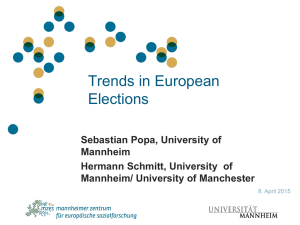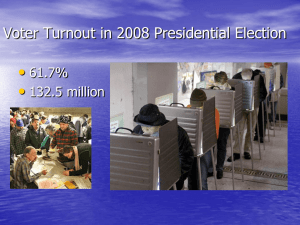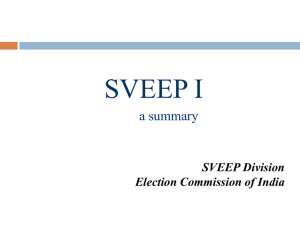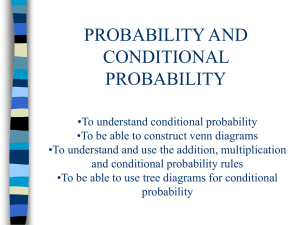GRAPHS, SUMMARY CHARTS And NOTES
advertisement
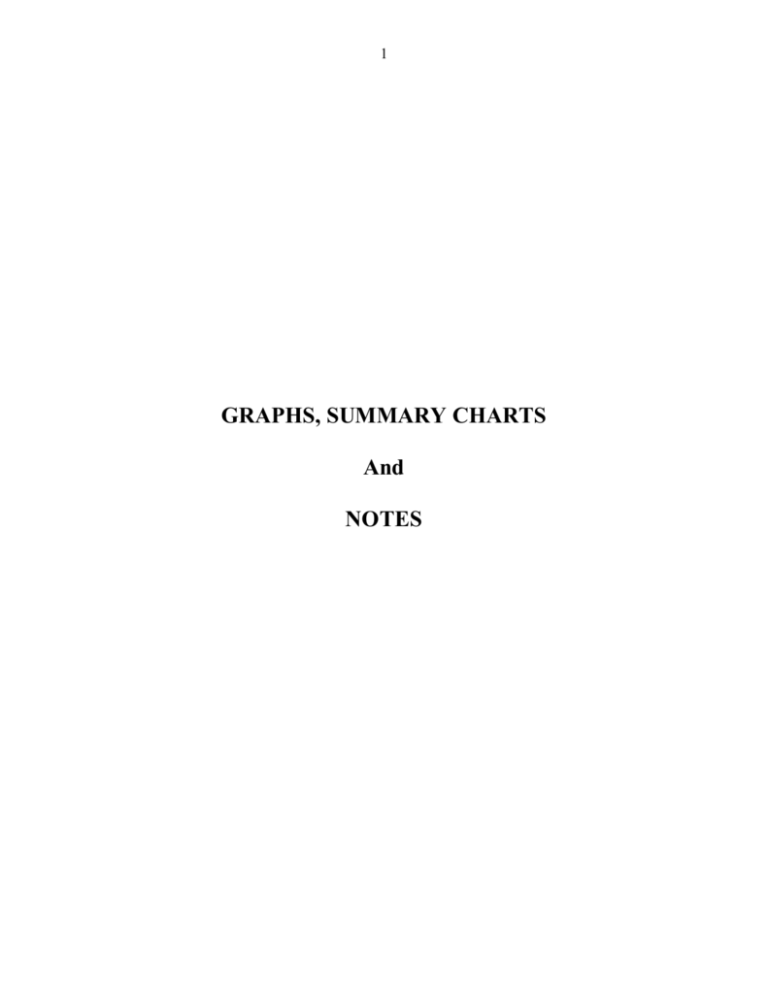
1 GRAPHS, SUMMARY CHARTS And NOTES 2 3 SUMMARY CHARTS AND NOTES 1. Overall Turnout: The average percentage of age-eligible citizens who voted in statewide primaries (for U.S. Senate and/or state governor) in 2014 and previous midterm elections: 2014 14.8 2010 18.3 2006 16.7 2002 18.6 1998 18.9 1994 20.7 1990 21.5 1986 21.4 1982 25.2 1978 25.2 1974 24.9 1970 31.9 1966 31.8 1962 29.7 4 2. Partisan Turnout: Percentage of age-eligible citizens who voted for each party in statewide primaries (for U.S. Senator and/or state governor) in the 2014 midterm primaries as compared to previous midterm primaries: YEAR Democratic Republican 2014 6.1 8.2 2010 8.7 9.6 2006 8.9 7.5 2002 10.2 8.2 1998 10.6 8.8 1994 11.7 8.5 1990 13.5 7.5 1986 13.6 7.3 1982 16.3 7.9 1978 17.3 8.2 1974 17.9 7.3 1970 20.6 10.8 1966 20.2 13.2 1962 19.6 11.5 5 3. States Setting New Record Low Turnout: Listed here as overall (for both parties) and by party with the percentage of eligible citizens who cast ballots in parentheses: Overall Democratic Republican Alabama (16.8) Alabama (5.0) Maine (5.1) Arkansas (15.2) Arkansas (7.0) Nevada (5.9) California (18.1) California (7.2) Pennsylvania (3.8) Georgia (13.3) Georgia (4.7) Idaho (15.6) Idaho (2.2) Illinois (14.2) Illinois (5.0) Iowa (9.7) Iowa (2.8) Maine (10.1) Montana (9.6) Maryland (16.9) Nevada (2.6) Nevada (9.9) Ohio (4.7) New Mexico (12.7) Oklahoma (5.9) Ohio (11.2) Oregon (10.5) Oklahoma (15.5) South Carolina (3.2) Oregon (19.8) South Dakota (4.4) South Dakota (16.4) Texas (3.3) 6 4. Four States with Record High Republican Turnout: Only the GOP produced record high turnout. They did so in four states listed below with the percentages of eligible citizens who voted: Arkansas (8.2) Mississippi – Runoff (17.2) Montana (16.8) Oklahoma (9.6) 7 5. IMPACT OF CONVENIENCE VOTING IN 2014 PRIMARIES State 2014 Overall Primary Turnout Compared to 2010 and Convenience Voting: Turnout differential between 2014 by state and whether the state had one or more of four types of convenience voting – Election Day Registration (EDR), In-person Early Voting EV, No Excuse Absentee Voting (NE)* and All Mail Voting (M). State and Percentage Point Difference From 2010 EDR EV NE* West Virginia (+4.8) X Nebraska (+4.4) X X North Carolina (+1.8) X X Idaho (-1.6) X X Maryland (-2.0) X Texas (-2.4) X Oklahoma (-2.7) X X Georgia (-2.9) Iowa (-3.1) M X X X X California (-3.2)** X X* New Mexico (-3.6) X X X X Kentucky (-4.3) Illinois (-4.6) Ohio (-4.9) Colorado (-5.1) Oregon (-5.2) South Carolina (-6.0) Alabama (-6.1) X X X X 8 State EDR Nevada (-6.8) EV NE X X M Pennsylvania (-7.1) Arkansas (-7.5 Maine (-14.5) X X X *Citizens may apply for permanent no-excuse absentee status and receive an absentee ballot prior to each election. **In the California statewide primary, sixty-nine percent of those voting did so by mail. Also, California’s primary was a “top two” primary. The two candidates receiving the most votes, regardless of party affiliation, moved on to the general election. (Notes: 1. Three states which held primaries this year did not have statewide primaries in 2010 (Mississippi, Montana and South Dakota). Despite the fact that Mississippi had none of these reforms, its runoff Republican primary boosted its turnout to the highest level ever. Montana’s turnout was the second lowest ever despite having election day registration and no excuse absentee voting. South Dakota’s turnout was the lowest ever despite having no excuse absentee voting. 2. The detailed charts appended to this report has comparisons with each midterm primary season back to and including 1998. As in the comparison between 2014, in each of these prior midterm elections (2006,2002 and 1998), only three states of 25 had higher turnout. They were, however, not the same states in each year. 9 NOTES 1. What is turnout: Turnout is at its root a simple equation – the amount of votes cast divided by those who are eligible to vote. But there are complexities to this simple equation: --The Votes: For turnout percentages to have meaning beyond a particular year, the votes need to be counted in the same way for each prior election year, so that they can be compared to prior and similar elections. One compares presidential election votes with previous presidential election votes and midterm votes against prior midterm election votes. The historical basis for comparing presidential year voting are the votes cast for president. This figure doesn’t capture all the votes cast. Some people vote only for offices below the level of president and there are miscast and mutilated ballots. But the only consistent historic record is for presidential votes. For mid-term general elections, the votes cast for the statewide contest (U.S. Senate or state governor) which draws the largest number of voters aggregated nationally from each state’s tallies is the figure used for determining national turnout. But in each mid-term election, there are states which don’t have statewide contests and, for those states, the aggregate votes cast for U.S. House or Representatives is added to the total from the other states. In the midterm primary season and because there are no comparable historical figures for U.S. House votes, only statewide contests are used in turnout calculations. (In mid-term elections, there are also ballots cast that contain no votes for statewide candidates and ballots that are rejected.) All vote counts in this report for this year and previous years are final, official and certified by the state official in charge of the vote count. With one exception, all the vote counts reflect the ballots cast in the original primary election. That exception is the Republican senatorial primary runoff in Mississippi which drew a substantially higher number of votes than the original primary election. The Republican runoff in Georgia might produce a higher turnout figure than the original primary, but in the vast majority of elections this year and in previous years, turnout is usually less in the runoffs. --The Eligible Vote: The denominator for determining turnout for all elections from 1860 to the present is the number of age-eligible citizens in each state (and, in presidential elections, the District of Columbia). Since 1870 and with the exceptions of 1960 and 2010, the decennial Censuses have provided a figure for those age-eligible in each state and for noncitizens in each state. The 1960 Census did not provide a figure for non-citizens and in 2010, the Census did not ask a citizenship question, but the American Community Survey did. In any event, the methodology used in this report is to take the figure for age-eligible, subtract the number of non-citizens and interpolate between Censuses. For 1860, the interpolation was based on the rate of change between the 1870 and 1880 Censuses and that rate was used for the interpolation backwards to 1860. After each Census, the age-eligible citizens for the elections between that Census and the next are determined by the rate of change between that Census (or American Community Survey) and the one previous and interpolating forward on the basis of that rate of change. Most of the time, this produces a reasonable approximation of the citizeneligible population. Occasionally the previous rate of change turns out not to be predictive. For instance, the rate of change indicated between the 1990 Census and the 2000 Census for the District of Columbia showed a continued decrease in population. The opposite was true. So after each Census, it is necessary to go back and correct for errors. 10 This figure is not perfect. It includes felons who are incarcerated and some who have served their time but can’t vote and people deemed incompetent in mental institutions who also can’t vote. It doesn’t include Americans living outside the United States who can vote and those who are naturalized in each election year who can vote but who won’t be accounted for until the following year. It also doesn’t correct for undercounts or overcounts in the Census. It is possible to get ballpark estimates for each of these imperfections, but there is no set of historical figures that might provide a comparison. So, those who attempt to create what they call a VEP are providing a figure that may or may not be accurate for a given election year, but is not useful for any historical or trend analysis. Thus for all analyses the Center for the Study of the American Electorate (CSAE) undertakes, the citizen-age-eligible figure is the denominator it uses. It corrects for the largest distortion (non-citizens) in the age-eligible or (VAP) figures that had been in used by almost everyone prior to 2000, except Dr. Walter Dean Burnham who developed the interpolation method of arriving at a citizen eligible figure. (It should be noted that the Census Bureau in its biennial survey on reported registration and voting uses citizen voting age population as its standard, though they arrive at their figures via a different method.) Burnham’s method created a citizen-age-eligible figure from the month of the release of the Census (usually but not always April) to that month in the ensuing election years. CSAE has carried that interpolation to November of each election year. CSAE uses the April to April figure as a denominator for primary elections and the November figure for general elections. This report is based on the April interpolation. (A fuller discussion of this set of issues and why determining turnout as a percentage of those registered is a bad idea can be found in CSAE’s final reports on the 2008, 2010 and 2012 elections and will be provided in its lengthier reports in 2014 -- at the end of primary season and in its two reports after the general election.) 2. The Data Charts: The comparison of national highest vote turnout figures are based on the average national turnout in each mid-term year. In some previous midterm election years, some of the states which held statewide primaries in 2014 did not hold them in a given previous year. In the detailed charts at the end of this report, there are also charts which show continuous data – those states which had statewide contests in all of the years from 1974 through 2014. Those charts do not show substantially different trend lines than those revealed by the charts used for comparison in the report. Through June, there were 25 statewide primaries with contests for both major parties. In New Jersey, only the votes in the Republican senatorial primary were recorded. The Democratic candidate, Sen. Cory Booker, ran unopposed and his votes were not counted. The overall turnout charts are based on the votes in those states which held statewide primaries in both parties. There is a separate chart on Republican races for U.S. that includes New Jersey. 4. Acknowledgements: There are many people to thank for their help over the years. On one level all the contributors who helped keep CSAE afloat for nearly 40 years. On another level, the state election officials who collect, scrutinize and publish the data that make CSAE’s reports possible and the many individuals who have served as research assistants to CSAE over the years 11 and NCSL for providing up-to-date changes in voting law. Special thanks is owed Samuel Schreiber who designed the database program that made CSAE’s reports possible, to Matthew Mulling who did the interpolation for this report and many prior and to Dr. Walter Dean Burnham who provided the guidance that this non-academic needed to produce thoughtful and defensible studies and analysis. 3. Responsibility: Curtis Gans, CSAE’s director, is solely responsible for the data and analysis in this report and for any errors that might be found by others.


